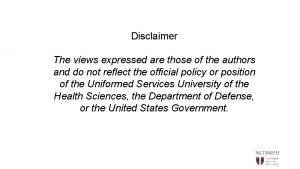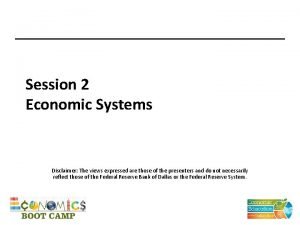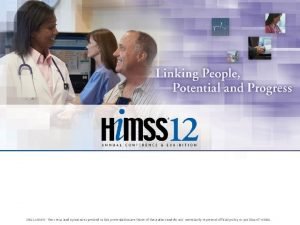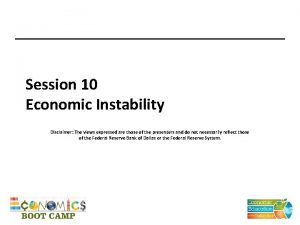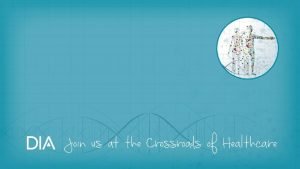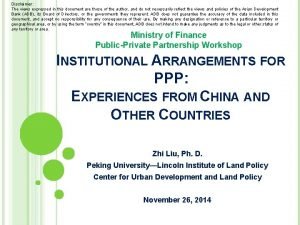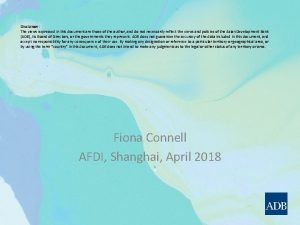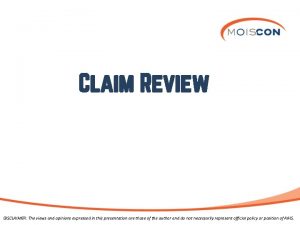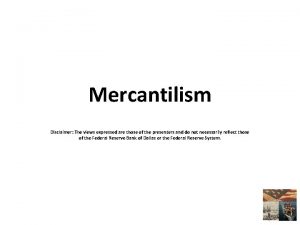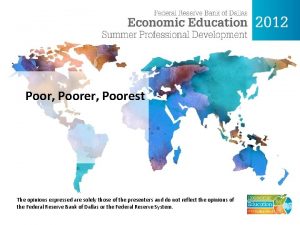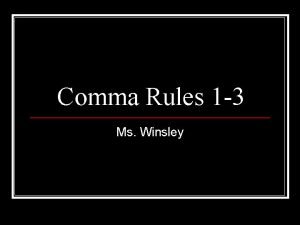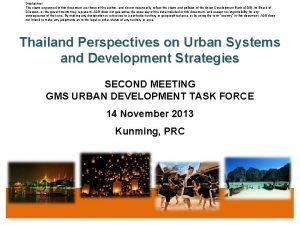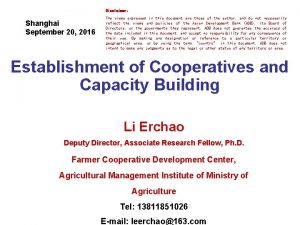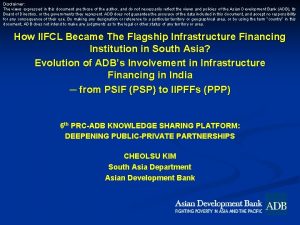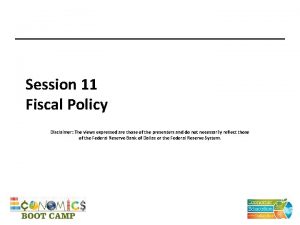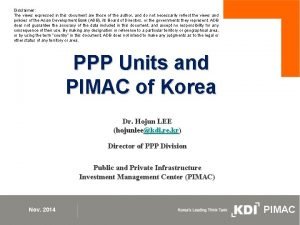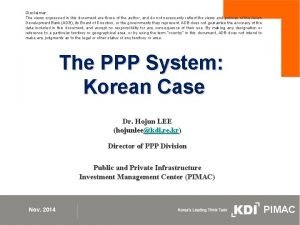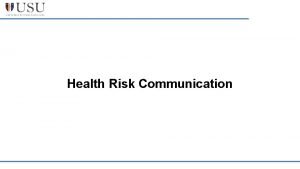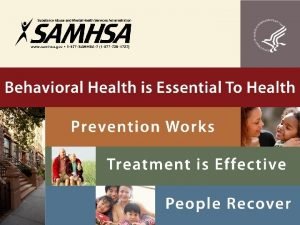DISCLAIMER Please note The views expressed within this























- Slides: 23


DISCLAIMER Please note: The views expressed within this presentation are the personal opinion of the author. They do not necessarily represent the views of the author’s academic institution or the rest of the NTRK and SARCOMA CONNECT groups. This content is supported by an Independent Educational Grant from Bayer. 2

INTRODUCTION 3

AN INTEGRATED APPROACH TO CARE IS KEY IN PAEDIATRIC ONCOLOGY • A multidisciplinary approach is key to long-term efficacy in paediatric oncology 1 • Cancer does not respect age boundaries (child/adolescent/adult)2 – Increased translation of treatment approaches between paediatric and adult care is beginning 2 1. Cantrell MA and Ruble K. J Multidiscip Healthc. 2011; 4: 171– 81; 2. Mody RJ, et al. Pediatr Blood Cancer. 2017; 64: 26288. 4

FROM EWING-LIKE TO CIC-DUX 5

LONG-TERM SURVIVAL: EWING SARCOMA • Long-term survival in adults is less favourable 2 – HR for death based on 5 -year overall survival (≥ 18 years vs < 18 years): 2. 02; 95% CI: 1. 53– 2. 67, P < 0. 0012 Patient survival 100 80 60 40 20 0 No. at risk Localised Metastatic Localised disease Metastatic disease P<0. 0001 0 2 4 6 8 Years 10 12 14 77 24 72 11 63 6 53 5 44 1 38 1 34 1 47 3 LONG TERM OS IN PAEDIATRIC VS ADULT EWING SARCOMA 2 100 Survival (%) • Long-term survival outcomes are excellent for localised paediatric Ewing sarcoma 1 LONG TERM OS IN PAEDIATRIC EWING SARCOMA 1 80 60 40 20 0 10 years 20 years < 18 years ≥ 18 years CI, confidence interval; HR, hazard ratio; OS, overall survival 1. Hamilton SN, et al. Am J Clin Oncol 2017; 40: 423– 8; 2. Davenport JR, et al. Pediatr Blood Cancer 2016; 63: 1091– 5 30 years 6

MOLECULAR CLASSIFICATION OF SMALL BLUE ROUND CELL TUMOURS • A number of molecular subtypes of small-round blue cell tumour have been defined in recent years 1– 3 PREDOMINANT CIC-DUX PHENOTYPE SHOWING SOLID SHEETS OF ROUND TO OVOID CELLS 3 • CIC-DUX 4 gene fusion is the most common mutation found in non‑Ewing (EWSR 1 -negative) small blue round cell tumours 2 Haematoxylin and eosin stain CIC-DUX 4, capicua–double homeobox 4; EWSR 1, Ewing sarcoma RNA binding protein 1 1. Folpe AL, et al. Am J Surg Pathol 2005; 29: 1025– 33; 2. Antonescu CR, et al. Am J Surg Pathol 2017; 41: 941– 49; 3. Carter CS, Patel RM. Surg Pathol Clin. 2019; 12: 191 -215. 7

CIC-DUX TUMOURS ARE A DISTINCT CLINICAL AND MOLECULAR TUMOUR SUBSET – Dx range 6– 81 years, mean 32 years 1 – 22% were < 18 years of age 1 • CIC-DUX tumours are aggressive with much less favourable outcomes that Ewing sarcoma 1 • Global initiatives will be necessary to allow pooling of data to test therapies in these newly defined rare molecular subtypes 2 SURVIVAL OUTCOMES IN CIC-DUX VS EWING SARCOMA 1 1. 0 Genetic rearrangement CIC EWSR CIC-censored EWSR-censored 0. 8 Cum. survival • Tumours with CIC-DUX fusions appears in children, adolescents, and adults 1 0. 6 0. 4 0. 2 P=0. 002 0. 0 0 100 200 300 400 500 Months CIC-DUX, capicua–double homeobox; Cum. , cumulative; Dx, diagnosis; EWSR, Ewing sarcoma RNA binding protein 1. Antonescu CR, et al. Am J Surg Pathol 2017; 41: 941– 49; 2. Mathoulin-Pélissier S, Pritchard-Jones K. Eur J Surg Oncol. 2019; 45: 22 -30. 8

NTRK GENE FUSIONS IN SARCOMA 9

NTRK GENE FUSIONS HAVE A HIGH INCIDENCE IN SARCOMA • NTRK genes (NTRK 1, NTRK 2 or NTRK 3) encode the TRK receptors (TRKA , TRKB and TRKC, respectively)1, 2 • There is a high incidence of NTRK gene fusions in both paediatric and adult sarcomas 1, 3 – Around ¼ of adult NTRK gene fusions positive tumours are sarcomas 2 TUMOURS CLASSIFICATION BY NTRK GENE FUSIONS 2 INCIDENCE OF NTRK GENE FUSIONS IN SARCOMA 3 Gynaecological 4% Cholangiocarcinoma Neuroendocrine 2% 6% Pancreatic 6% Sarcoma 24% CRC 7% Thyroid 9% Breast 11% NSCLC 19% MASC 13% • Sarcoma NOS, n=7 • Cervical adenosarcoma, n=1 • Dedifferentiated chondrosarcoma, n=1 • Endometrial stromal sarcoma, n=1 • Follicular dendritic cell sarcoma, n=1 • GIST, n=1 • MPNST, n=1 CRC, colorectal cancer; GIST, gastrointestinal stromal tumour; NOS, not otherwise specified; MASC, mammary analogue secretory carcinoma; MPNST, malignant peripheral nerve sheath tumour; NSCLC, non-small cell lung cancer; NTRK, neurotrophic tropomyosin-related kinase; TRK, tropomyosin receptor kinase 1. Cocco, et al. Nat Rev Clin Oncol 2018; 15: 731– 47; 2. NTRK CONNECT Blue. Print. Available from: https: //ntrkconnect. info/ntrk-gene-fusions-trk-inhibitors-and 10 testing-approaches-blueprint/. Accessed March 2020; 3. Doebele, et al. Lancet Oncology 21: 271 -282; 21: 271– 82

TRK-INHIBITION PROVIDES ROBUST RESPONSES IN PATIENTS WITH NTRK GENE FUSION-POSITIVE SARCOMA EFFICACY OF LAROTRECTINIB IN SARCOMAS HARBOURING TRK FUSIONS: BEST CHANGE IN TARGET LESIONS +93. 2 % 50 40 Maximum change in tumour size (%) 30 20 10 0 -10 -20 -30 -40 -50 -60 -70 -80 -90 STS IFS -100 Data cut-off: Feb 19, 2019 GIST Bone sarcoma IFS, infantile fibrosarcoma; NTRK, neurotrophic tropomyosin receptor kinase; STS, soft tissue sarcoma; TRK, tropomyosin receptor kinase; GIST, gastrointestinal stromal tumour 11 Demetri GD, et al. CTOS 2019. Abstract #3254588

TRK-INHIBITION PROVIDES DURABLE RESPONSES IN PATIENTS WITH NTRK GENE FUSION-POSITIVE SARCOMA PROGRESSION-FREE SURVIVAL DURATION OF RESPONSE 75% 75 50 Median: NE (range 1. 6+ to 44. 2+ months) Median follow-up: 15. 6 months 25 0 6 12 18 24 30 36 42 48 Months from start of response No. at risk 54 37 22 14 9 2 1 1 0 100 86% 75 Overall survival (%) Duration of response (%) 91% Progression-free survival (%) 100 0 OVERALL SURVIVAL 67% 50 Median: 28. 3 months (95% CI 16. 8–NE) Median follow-up: 13. 0 months 25 0 0 6 12 18 24 30 36 42 48 Months from start of treatment 71 41 25 20 10 3 1 1 0 91% 75 50 Median: 44. 4 months (95% CI 44. 4–NE) Median follow-up: 14. 1 months 25 0 0 6 12 18 24 30 36 42 48 Months from start of treatment 71 53 36 29 17 8 3 2 0 Data cut-off: Feb 19, 2019 NE, not estimable; NTRK, neurotrophic tropomyosin receptor kinase; TRK, tropomyosin receptor kinase Demetri GD, et al. CTOS 2019. Abstract #3254588 12

WHERE CAN WE FIND NTRK GENE FUSIONS IN SARCOMA? • It is unclear which of the many sarcoma subtypes are likely to harbour NTRK gene fusions • Screening methods are expensive and must be targeted • Tumours with translocations of EWSR 1 in Ewing sarcoma or KIT in GIST are unlikely to harbour NTRK gene fusions – More research is required to confirm these observations ESTABLISHED TUMOUR SUBTYPES WITH NTRK GENE FUSIONS • Infantile fibrosarcoma with ETV 6‑NTRK 3 gene Fusions 1 • Wild-type GIST 2 EMERGING TUMOUR SUBTYPES WITH NTRK GENE FUSIONS • Spindle cell tumours with RAF 1, BRAF & NTRK 1/2 gene fusions 3 • Infantile fibrosarcoma-like with BRAF & NTRK 1 gene fusions 4, 5 • Lipofibromatosis-like neural tumours with NTRK 1 gene fusions 6 • NTRK 3 gene fusions positive sarcomas 5 ETV 6, translocation-ETS-leukaemia; EWSR 1, Ewing sarcoma RNA binding protein 1; GIST, gastrointestinal stromal tumour; KIT, proto-oncogene c-KIT; NTRK, neurotrophic tropomyosin receptor kinase 1. Fletcher CDM et al. WHO Classification of Tumours of Soft Tissue and Bone. 4 th ed. Lyon, France: IARC Press; 2013. ; 2. Cocco E, et al. Nat Rev Clin Oncol 2018; 15: 731– 47; 3. Suurmeijer AJH, et al. Genes Chromosomes Cancer 2018; 57: 611– 21; 4. Kao Y-C, et al. Am J Surg Pathol 2018; 42: 28– 38; 5. Agaram NP, et al. Am J Surg Pathol 2016; 40: 1407– 16; 6. Suurmeijer AJH, et al. Genes Chromosomes Cancer 2019; 58: 100– 10 13

SUCCINATE-DEHYDROGENASE DEFICIENT GIST 14

SDH-DEFICIENT GIST PREDOMINATES IN THE UNDER 20 s KIT/PDGFRA GENOTYPES PREDOMINATE IN GIST OVERALL 1, 2 SDHB NEGATIVE (SDH-DEFICIENT) GIST BY AGE GROUP 4 • 80– 90% of GIST cases are positive for a KIT or PDGFRA mutation • GIST in the paediatric and young adult population displays a different pattern of mutations 3 Negative Positive 200 Number of patients – KIT positive approximately 65– 75% – PDGFRA positive approximately 10 – 20% 250 100 50 0 0 -19 20 -29 30 -39 40 -49 50 -59 60 -69 70 -79 80 -89 90 -99 Age (years) Slide adapted from S. Bauer, ESMO Sarcoma and GIST 2020 BRAF, proto-oncogene B-Raf; FGFR 3, Fibroblast Growth Factor Receptor 3; GIST, gastrointestinal stromal tumour; KIT, proto-oncogene c-KIT; PDGFRA, plateletderived growth factor receptor alpha; PIK 3 CA, phosphatidylinositol-4, 5 -bisphosphate 3 -kinase catalytic subunit alpha; SDH, succinate dehydrogenase; SDHB, succinate dehydrogenase complex iron sulphur subunit B. 1. Heinrich MC. ASCO 2010: educational session; 2. Mavroeidis L, et al. ESMO Open. 2018; 3: e 000335; 3. Rink L, Godwin AK. Curr Oncol Rep. 2009; 11: 314; 4. Miettinen M, et al. Am J Surg Pathol 2011; 35: 1712– 21 15

SUNITINIB HAS EFFICACY IN KIT/PDGFRA WT PAEDIATRIC GIST BASELINE CHARACTERISTICS AND RESPONSE TO TREATMENT IN PAEDIATRIC GIST PATIENTS Age Genotype Case Dx 1 17 17 F 2 8 10 3 13 4 Study entryb Gender Morphology Responsea Time to tumour progression KIT PDGFRA IM SU SU versus IM Epithelioid WT WT PD SD <1 7 +6 F Epithelioid WT WT Adjuvant PR 14 >21 +7 16 F Epithelioid WT WT SD SD 12 8 – 4 15 16 M Epithelioid WT WT SD SD 16 18 +2 5 15 16 F Spindle WT WT PD SD <1 >18 +17 6 16 16 M Mixed NA NA PD PD <1 <1 0 7 NA 14 F NA NA NA SD SD 12 18 +6 a. Assessed based on RECIST; b. Age at time of enrolment Slide adapted from S. Bauer, ESMO Sarcoma and GIST 2020 Dx, age at diagnosis; F, female; GIST, gastrointestinal stromal tumour; KIT, proto-oncogene c-KIT; IM, imatinib; M, male; NA, not available; PD, progressive disease; PDGFRA, platelet-derived growth factor receptor alpha; PR, partial response; RECIST, Response Evaluation Criteria in Solid Tumours; SD, stable disease; SU, sunitinib; WT, wild-type 16 Janeway KA, et al. Pediatr Blood Cancer 2009; 52: 767– 71

REGORAFENIB HAS DEMONSTRATED EFFICACY IN METASTATIC SDH-DEFICIENT GIST PFS IN FULL POPULATION a CBR AND PFS BY GENOTYPE 120 Proportion progression-free 1. 00 100 0. 75 79 80 Median PFS = 13. 2 months (95% CI: 9. 2 to 18. 3) 0. 50 60 67 59 40 0. 25 20 0 0 6 12 18 24 30 36 42 5 1 Time (months) No. at risk 32 26 18 11 7 5 18 13. 4 9 5. 7 10 0 KIT Exon 11 Genotype (%) KIT Exon 9 CBR (%) SDH deficient Median PFS (months) a. Patients with metastatic GIST refractory to standard TKI therapy (at least imatinib and sunitinib) Slide adapted from Bauer S. ESMO Sarcoma and GIST 2020 CBR, clinical benefit rate; CI, confidence interval; ESMO, European Society for Medical Oncology; GIST, gastrointestinal stromal tumour; KIT, proto-oncogene c-KIT; PFS, progression-free survival; SDH, succinate dehydrogenase; TKI, tyrosine-kinase inhibitor Ben-Ami E, et al. Ann Oncol 2016; 27: 1794– 9 17

REGORAFENIB HAS DEMONSTRATED EFFICACY IN METASTATIC SDH-DEFICIENT GIST PFS IN FULL POPULATION a CBR AND PFS BY GENOTYPE Proportion progression-free 1. 00 Patients (%) CBR % (95% CI) Median PFS (months) KIT Exon 11 19 (59) 79 (54 to 94) 13. 4 KIT Exon 9 3 (9) 67 (9 to 99) 5. 7 SDH deficient 6 (18) 100 (54 to 100) 10 BRAF exon 15 1 (3) 0 N/A SDH unknown, BRAF intact 1 (3) 0 N/A Unknown 3 (9) 67 (9 to 99) N/A 33 (100) 76 (58 to 89) 13. 2 Genotype 0. 75 Median PFS = 13. 2 months (95% CI: 9. 2 to 18. 3) 0. 50 0. 25 Total 0 0 6 12 18 24 30 36 42 5 1 Time (months) No. at risk 32 26 18 11 7 5 a. Patients with metastatic GIST refractory to standard TKI therapy (at least imatinib and sunitinib) Slide adapted from Bauer S. ESMO Sarcoma and GIST 2020 CBR, clinical benefit rate; ESMO, European Society for Medical Oncology; GIST, gastrointestinal stromal tumour; KIT, protooncogene c-KIT; PFS, progression-free survival; SDH, succinate dehydrogenase; TKI, tyrosine-kinase inhibitor Ben-Ami E, et al. Ann Oncol 2016; 27: 1794– 9 18

TARGETING OF KIT AND FGFR MAY OFFER A NEW APPROACH IN SDH-DEFICIENT GIST RESPONSE OF MOUSE PDX CONFIRMS DEPENDENCE OF SDH-DEFICIENT GIST ON FGF SIGNALLING 2, 500 Tumour size (mm 3) Observation No treatment 28 -day treatment During treatment: a Vehicle control +672% * KIT inhibition +482% * ** * FGFR inhibition – 10% * * Combination – 36% 2, 000 1, 500 During observation: a FGFR inhibition * * Combination * 1, 000 500 0 0 10 20 30 40 50 Days a. P values reflect the difference in tumour growth between groups per two-way ANOVA (*P < 0. 05, **P < 0. 001, ***P < 0. 0001) ANOVA, analysis of variance; FGF, fibroblast growth factor; FGFR, FGF receptor; GIST, gastrointestinal stromal tumour; KIT, proto-oncogene c-KIT; PDX, patient-derived xenograft; SDH, succinate dehydrogenase Flavahan WA, et al. Nature 2019; 575: 229– 33 19

SUMMARY • Cancer does not respect age boundaries, a multidisciplinary approach should bridge paediatric and adult cancer care • Pooling of global data will be a necessary approach in rare molecular tumour subtypes • CIC-DUX positive tumours are a distinct from Ewing sarcomas and have less favourable outcomes • Sarcomas represent around 25% of tumours with NTRK gene fusions – TRK-inhibitors have demonstrated robust and durable responses • SDH-deficient GIST predominates in the under 20 s – Sunitinib and regorafenib have demonstrated efficacy in SDH-deficient GIST CIC-DUX, capicua–double homeobox; GIST, gastrointestinal stromal tumour; SDH, succinate dehydrogenase; NTRK, neurotrophic tropomyosin receptor kinase; TRK, tropomyosin receptor kinase 20

REACH SARCOMA CONNECT VIA TWITTER, LINKEDIN, VIMEO & EMAIL OR VISIT THE GROUP’S WEBSITE http: //www. sarcomaconnect. info Follow us on Twitter @sarcomaconnect Follow the Sarcoma CONNECT group on Linked. In Watch us on the Vimeo Channel Sarcoma CONNECT Email Froukje. sosef 1 @cor 2 ed. com 21

REACH NTRK CONNECT VIA TWITTER, LINKEDIN, VIMEO & EMAIL OR VISIT THE GROUP’S WEBSITE http: //www. ntrkconnect. info Follow us on Twitter @ntrkconnectinfo Follow the NTRK CONNECT group on Linked. In Watch us on the Vimeo Channel NTRK CONNECT Email froukje. sosef @cor 2 ed. com 22

Sarcoma CONNECT Bodenackerstrasse 17 4103 Bottmingen SWITZERLAND NTRK CONNECT Bodenackerstrasse 17 4103 Bottmingen SWITZERLAND Dr. Antoine Lacombe Pharm D, MBA Phone: +41 79 529 42 79 antoine. lacombe@cor 2 ed. com Dr. Froukje Sosef MD Phone: +31 6 2324 3636 froukje. sosef@cor 2 ed. com
 The views expressed here disclaimer
The views expressed here disclaimer The views expressed disclaimer
The views expressed disclaimer The views and opinions expressed disclaimer
The views and opinions expressed disclaimer Views disclaimer
Views disclaimer The views expressed
The views expressed Disclaimer the views expressed
Disclaimer the views expressed The views expressed disclaimer
The views expressed disclaimer The views and opinions expressed
The views and opinions expressed All opinions expressed disclaimer
All opinions expressed disclaimer Disclaimer the opinions expressed
Disclaimer the opinions expressed The views and opinions expressed
The views and opinions expressed Raymond carver will you please be quiet please
Raymond carver will you please be quiet please Please note comma
Please note comma Simple discount
Simple discount Draw a specimen of debit note
Draw a specimen of debit note Difference between note making and note taking
Difference between note making and note taking What is debit note
What is debit note Difference between note making and note taking
Difference between note making and note taking Singnal words
Singnal words Note making advantages
Note making advantages Financial documents order
Financial documents order Chúa yêu trần thế
Chúa yêu trần thế Các châu lục và đại dương trên thế giới
Các châu lục và đại dương trên thế giới Từ ngữ thể hiện lòng nhân hậu
Từ ngữ thể hiện lòng nhân hậu
